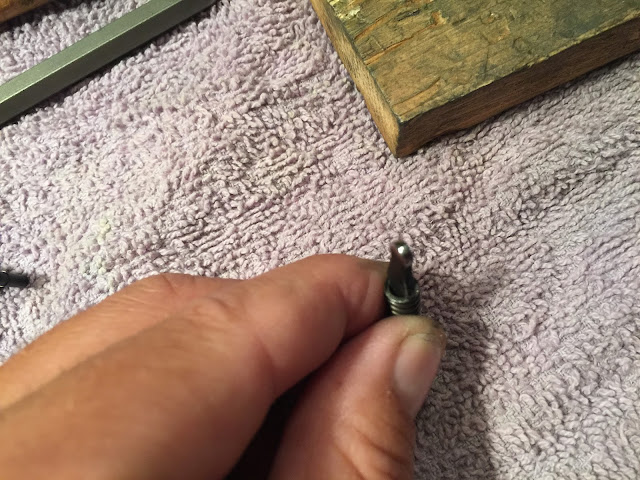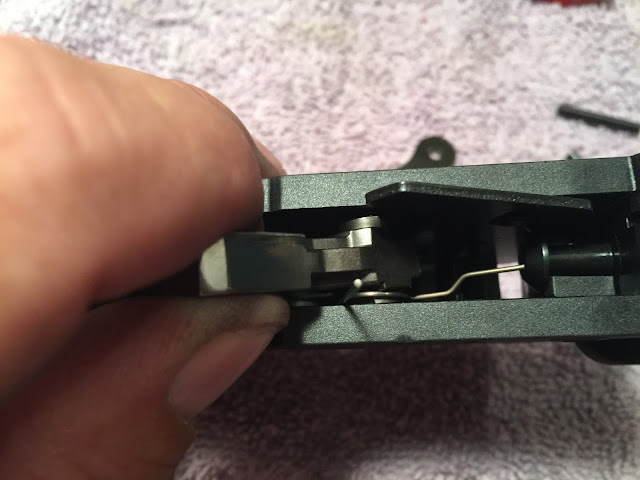For those that don't know, the Ruger Charger is a semi-auto pistol based on the 10-22 Rifle platform.
The pistol was originally introduced in 2007. It came with a black/gray laminated wood stock with carved pistol grip, scope mounting rail, a Harris bi-pod (or a Harris copy), a 10" heavy barrel and the standard 10 round rotary magazine.
Ruger also threw in a nice carrying case
I am guessing the idea probably stemmed from this guy:
The M1 Carbine pistol, called the "Enforcer."
As a side note, an M1 Carbine Enforcer was used by Patty Hearst during the infamous bank robbery
The 1st iteration of the Charger was popular, but Ruger ended their production in 2013, perhaps in anticipation of this new version? or perhaps the evil genius' at Ruger were trying to create demand by taking something away?
The new Charger, brought back in December 2014, it also comes with laminated stocks, but will have a removable AR-15 compatible grip. This allows the owner to customize the grip by using one from Hogue, Magpul, Ergo, ATI and others.
The 10" barrel comes threaded with the de-facto standard 1/2 - 28 treads for adding a suppressor or other muzzle accessory
Two models are available, the standard one with a brown laminated wood stock and a take down model with a green/brown laminated wood stock. Both stocks have aggressive "shark gills" on the fore-end to aid in off-hand shooting.
Both models come sans sights, Ruger assumed every owner would install an optical sight and thus equipped the pistol with a picatinny rail and nothing else.
Ruger did include a bi-pod for bench rest shooting though.
Just before this blog was published Ruger announced it is now offering both of the Charger models with a black polymer stock
Stats:
.22 Long Rifle Caliber
10" Alloy Steel Barrel with 6 grooves and 1:16" twist
19.25" overall length
3.1 lbs
It took many moons for my Charger to arrive (they were on back-order I guess), we went in with a few others and made a "group buy" to get free shipping.
The gun arrived in a big white box
The contents of the big white box were:
- A zippered, padded, Ruger monogrammed carrying case
- The Owner's Manual & appurtenant paperwork
- Safety pad lock
- A UTG bipod (with swivel adapter)
- The Ruger Charger w/ one BX15 Magazine
The UTG bipod removed from its container
Installation was a snap:
- put the picatinny rail over the swivel
- remove the knurled lock ring from the adapter
- slide the adapter over the swivel
- insert the locking screw through the hole in the swivel & adapter, screw it in most of the way
- reinstall the lock ring and snug it tight
- install the bipod on the picatinny rail and tighten the thumb screw
Installed on the gun, you can mount the picatinny rail forward or rearward. I installed mine to the front, it just seemed to look better that way. The bipod puts the bore center line about 8.5" off the bench, with the legs extended you get an additional 1/2".
My immediate plans for this gun include:
- Trigger/Action job
- KIDD bolt buffer
- Hogue AR grip
- BSA 42mm Red Dot Scope
- Custom carry case
I ordered this BSA 42mm Red Dot scope, and the Hogue AR grip, both were ordered on ebay, but they are also available on Amazon
The installation of the Hogue grip was straight forward. I removed the upper screw that attaches the grip adapter to the stock just for reference, you really only need to remove the allen bolt inside the grip (3/16" allen wrench)
If you do remove the grip adapter screw, be sure to use a hollow ground screw driver like this #14 Forester
A perfect fit
The sight came with a reversible mount for 3/8" rails (22 small rail) or 5/8" (Weaver/Picatinny). The forward bolt is slotted for easy mounting. With the red dot scopes, the eye relief is not really an issue, so I mounted it in the center of the rail.
Now onto the action job!
The action job starts with dis-assembly
Like all 10-22s you remove the stock bolt in the center of the stock just ahead of magazine well
Then push the safety button to the "neutral" position (between fire and safe) and pull the barreled action from the stock
next remove the pins holding the trigger assembly in place
and the bolt stop pin
Then pull the bolt to the rear and lift up on the front of it until it clears the guide
Next remove all the pins from the trigger assembly, it doesn't matter what order, but be careful not to lose any springs!
Now we start polishing the parts. I'll start with the hammer strut. The rounded end fits in a slot in the back of the hammer and rotates with metal to metal contact, well sand and polish the end to reduce friction
After polishing
The hammer is next, it has two surfaces that need to be slicked up, the front side where the bolt rides on it when cocking
and the bottom where it engages the sear
Next is the dis-connector, we simply polish the top side where it meets the sear
after
Next up is the sear, we have three areas to cover, the bottom where it contacts the dis-connector
The top side where the hammer rotates against it
and the end where the trigger dis-connector resets the trigger
After polishing
The last piece in the trigger assembly is the trigger return spring plunger, this rides against the back of the plastic trigger
using the drill makes it easier and faster
It was difficult to get a clear picture, but you can tell we radiased the edges and polished it smooth
There may be multiple ways to put these together, but this is the way I do it....
First install the coli spring and trigger return plunger. This spring is the larger of the two coil springs
Next assembler the trigger with the dis-connector and sear. The smaller coil spring goes in between the sear and dis-connector. The smallest pin holds the dis-connector in place.
Then I very carefully lower the trigger sub assembly into the housing and use a punch to line up the pin holes
Next I install the bolt release and the magazine release. The magazine button goes in from the front with its coil spring, the bolt release goes in from the top and the mag release lever goes in from the bottom, a pin at the bottom keeps them all in place
Next I install the hammer strut/spring assembly and the hammer. There is a wound spring that goes on the right side of the hammer (muzzle facing away from you) with both ends pointing up. once everything is in, line up the holes and insert the large pin
Here is the orientation of the wound spring, the bent end has to go this way for everything to work
You can see the other end of the spring is sticking up, we'll deal with that next
The final pin and part, this is the ejector
Put the ejector in its slot and start inserting the pin, do not go all the way, the spring leg that is sticking up must go under this pin, use a punch to hold the spring leg under the pin, while you push the pin all the way home
Next we tackle the bolt....We want to polish the sides of the firing pin and the extractor.
Removing the firing pin is pretty easy, just find the correct size punch (I used a 5/32 Grace punch) to and knock out the drift pin 7/8 of the way, no need to completely remove it from the bolt
 Be careful when pulling out the firing pin, the spring lays in the bottom of the trough...put it in a safe place
Be careful when pulling out the firing pin, the spring lays in the bottom of the trough...put it in a safe place
The extractor can be tough to remove, but not with this handy dandy Gunsmither 10/22 bolt bar

Before polishing...the extractor looks pretty rough, the ugly finish is left over from the hardening process

After polishing

I put the extractor & firing pin back in place, I then polished the bottom of the bolt where it pushes back on the hammer
Now that everything is back in place time to re-assemble the gun. The Gunsmither Tool has another use, it makes installing the bolt a snap. It is sometimes difficult to hold back the recoil spring and keep the guide rod straight, this does that part for you allowing you to simply drop in the bolt
As with all my 10-22s I purchased a KIDD bolt buffer, which consists of a heavy duty rubber sleeve and a hardened steel pin. This cushions the bolt when it reaches maximum travel
Just push the rubber sleeve into the hole
and push in the steel pin
Last step is to install everything back into the stock....remember to make sure the safety is in the "neutral" position
The trigger pull after the action job was much improved, you could definitely feel the difference when compared to one of the other Chargers that was purchased in our group buy
I used my Laserlyte bore site tool to get the scope close to dialed in, then headed to the range to put some holes in paper.
After a few rounds and some minor adjustments to the scope, I had it shooting in the bulls-eye.
The target below was shot at from 25 yards using Remington "Golden Bullet" 36 grain HP cartridges. There are three 3-shot groups on the target. Not to shabby!
BTW we had zero malfunctions, the gun operated smooth as silk.
Now I need to find a suitable gun case....I'll update this post when I make that happen.
References
Wikipedia
Ruger

























































where did you get the rubber grip for that beautiful 1022 Charger
ReplyDeleteIt is a Hogue, same as used on the AR-15 rifles
ReplyDelete